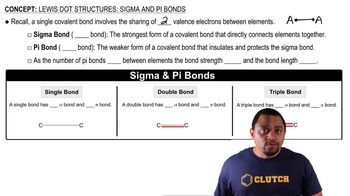Here are the essential concepts you must grasp in order to answer the question correctly.
Orbital Hybridization
Orbital hybridization is the process by which atomic orbitals mix to form new hybrid orbitals that can accommodate bonding. In the case of p orbitals, two p orbitals from different atoms can overlap to form a sigma (σ) bond, which is characterized by head-on overlap, allowing for strong bonding between the atoms.
Recommended video:
Sigma (σ) and Pi (π) Bonds
Sigma (σ) bonds are formed by the end-to-end overlap of orbitals, which can include s and p orbitals, resulting in a bond that allows for free rotation around the bond axis. In contrast, pi (π) bonds are formed by the side-to-side overlap of p orbitals, which occurs above and below the bond axis, restricting rotation and contributing to the double or triple bond character in molecules.
Recommended video:
Lewis Dot Structures: Sigma & Pi Bonds
Molecular Orbital Theory
Molecular orbital theory describes how atomic orbitals combine to form molecular orbitals that can be occupied by electrons. This theory helps explain the bonding and anti-bonding interactions between orbitals, providing a framework for understanding the stability and properties of molecules formed by the combination of p orbitals, particularly in the context of σ and π bonds.
Recommended video:

 Verified step by step guidance
Verified step by step guidance


